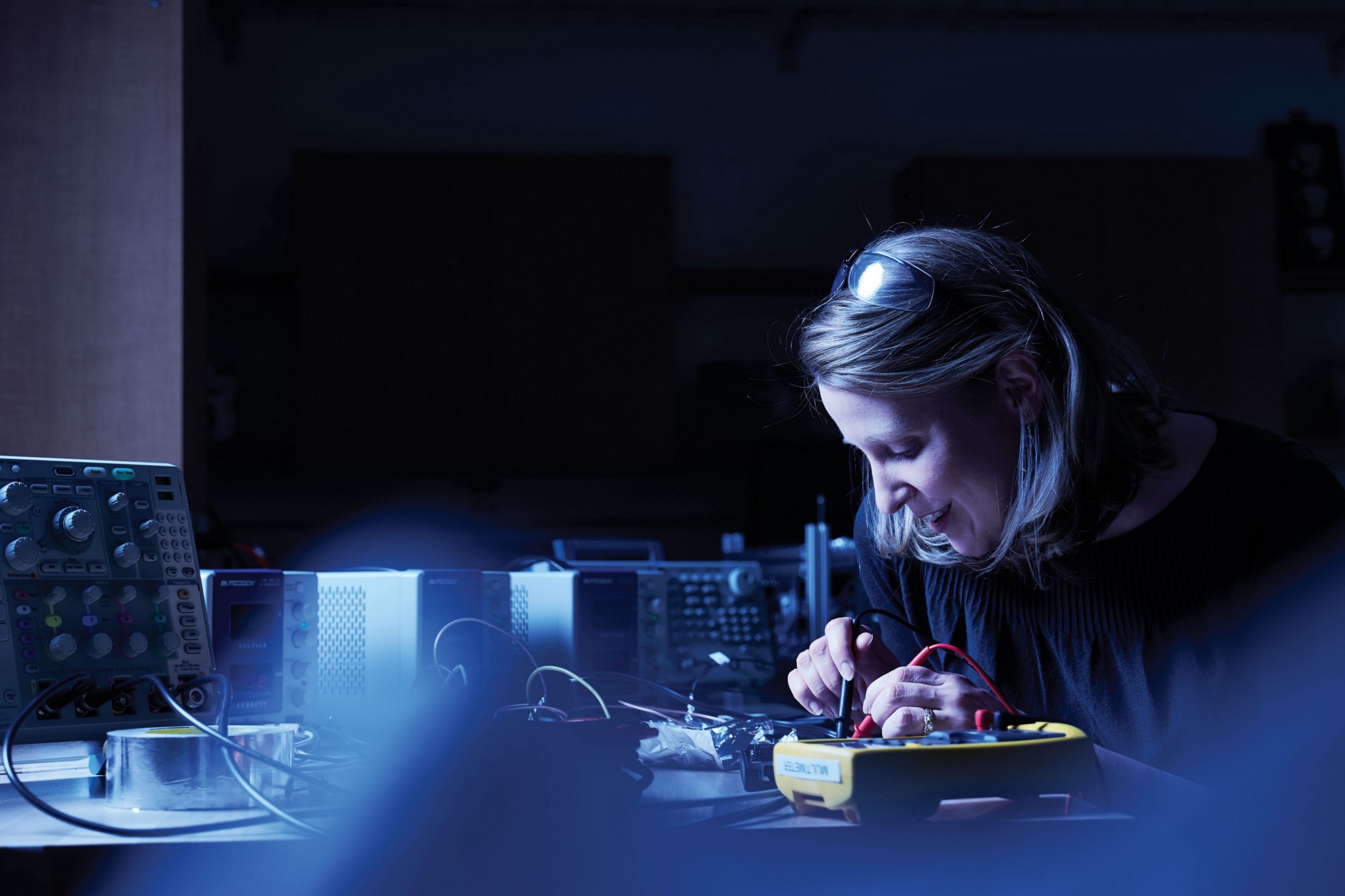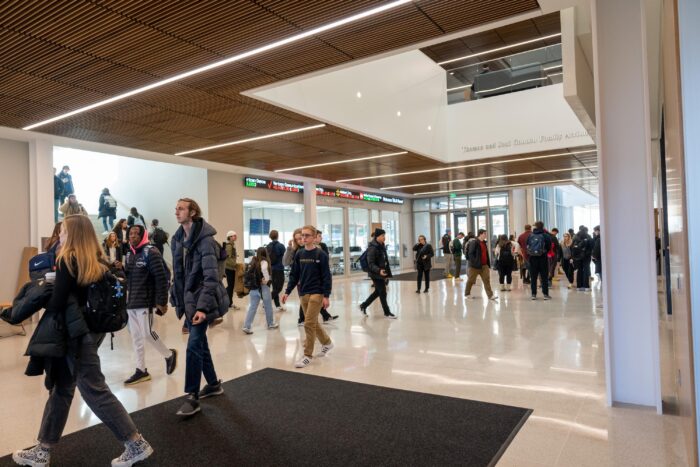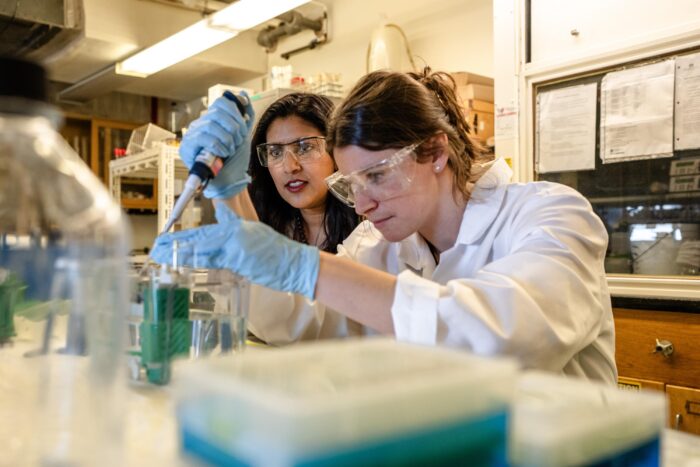This story first appeared in Radiations magazine, the official publication of the physics & astronomy honor society, Sigma Pi Sigma
As a child, Karen Andeen was fascinated with stories about exploring the uncharted world. By the time she reached high school, it became clear that one world still ripe for discovery was that of particle physics, brought to life by a gifted teacher, Saul Ploplys, who inspired Andeen and many of her classmates to pursue careers in the field.
Andeen has now spent two decades studying particles known as cosmic rays that are ejected by violent astrophysical events like supernovas, black holes, and galaxy collisions. “Just figuring out what the cosmic rays are—what fraction of the particles smashing into our atmosphere are oxygen or helium or hydrogen nuclei—helps us understand the physics behind the huge events that produced those particles,” she says. “I often tell people that it’s like space archaeology: Archaeologists use shards of pottery to not only reconstruct the original pot but also to understand the culture that produced it thousands of years ago. Similarly, astrophysicists use particles smashing into Earth from space to understand the physical mechanisms behind astrophysical events like supernovae.”
Her work has taken her to Geneva, Switzerland, and the IceCube Neutrino Observatory at the South Pole. Today she’s analyzing data and designing new observational tools for IceCube using funds from a coveted National Science Foundation CAREER grant. Working with existing IceCube detectors, the prototype telescopes built by Andeen’s international team will allow researchers to precisely identify the cosmic ray types.
Aside from research, one of Andeen’s main career goals is to make science accessible to more people by knocking down unnecessary barriers and making it easier to navigate the various stages of a STEM career. As an associate professor of physics at Marquette University in Milwaukee, Wisconsin, Andeen thinks often about how to improve physics education for what she hopes will be an increasingly diverse student body. She is the first woman to earn tenure in the university’s physics department, and over the course of her career, she has become deeply interested in teaching for inclusivity.
“If you aren’t focused on making sure everyone feels deliberately included, then some people are feeling excluded and others are feeling singled out,” she says. “Inclusivity has to be for absolutely every individual in the classroom.”
From Ploplys, Andeen came to understand the importance of context when teaching. “He did a great job of bringing in not just the physics but also the stories of the physicists and their lives,” she says. “He made it clear that they all did stupid stuff and made mistakes and didn’t get it right the first time. And that made it feel accessible.”
To this end, Andeen doesn’t shy away from being honest about the role that struggle and failure play in success. As a woman in a male-dominated field (fewer than a quarter of bachelor’s degrees1 and PhDs2 in physics are awarded to women), Andeen has faced her share of challenges, from sexual harassment and unequal treatment to “simply balancing work and family life” as a professor.
“I’m a pretty private person, but I share quite a lot about myself with students—and even colleagues—so they know the obstacles I’ve faced, how I tackled them, and how I managed to succeed in spite of them,” she says. “No one can empathize with challenges they don’t even know exist, yet many people struggling in their own ways don’t feel able to share their experiences. I’m lucky to be in a very privileged position at this point in my career, so I feel obliged to speak out for those who can’t.”
Andeen says she’s especially lucky to have had support from family, friends, and colleagues, as well as great role models. Cecilia Vogel was an early role model for Andeen. Vogel is a nuclear physics professor at Augustana College and the first real-life example Andeen encountered of a physicist who is also a mom. “It was very inspiring to see someone successfully doing both—I realized that I didn’t have to choose between having a family and being a scientist,” she says. “I won’t say that it’s easy, but it’s definitely possible.”
Andeen is quick to remind her students that science is not a single moment of genius: It’s a life’s work that is fueled by our experiences. “Physics students tend to become intimidated when learning about people like Einstein or Newton, so it’s very important to help them realize that those ‘geniuses’ combined a lot of information over time—and not just academic information but also information gathered through their daily lives and personal interactions,” she says.
“We have big problems in our world today—not just in physics—and we need as many diverse perspectives, experiences, and ideas as we can gather to find solutions. Maybe some of them are yours.”
References
- The American Institute of Physics, “Percent of Physics Bachelor’s Earned by Women, Classes of 1976 to 2020,” October 2021, aip.org/statistics/data-graphics/percent-physics-bachelor’s-earned-women-classes-1976-2020.
- The American Institute of Physics, “Percent of Physics PhDs Earned by Women, Classes 1980 through 2019,” February 2021, aip.org/statistics/data-graphics/percent-physics-phds-earned-women-classes-1980-through-2019.



